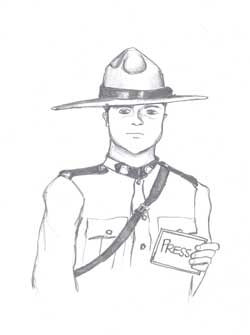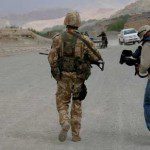Taking Cover
There's no law against police officers posing as journalists. They say it's part of how they do their job. But while it may make their work easier, it does the opposite for reporters. Now, journalists are taking on the law
It was a simple assignment: when the third in a string of pipeline explosions shook the northern British Columbia community of Dawson Creek this Halloween, Tamara Cunningham was sent out to cover it. A former reporter to the Dawson Creek Daily News, Cunningham realized as she drove up to the site that access wasn’t going to be easy. The road leading to it was blocked by security-no one was yet sure if these were deliberate attacks. It was, her boss stressed, an important story to get, so Cunningham did what most reporters would and got creative.
Taking a side road, she found a farmhouse that backed on to the field where the pipeline was laid. She parked in front of it. An unmarked van pulled up behind her. The driver identified himself as James, a freelance reporter from the Alaska Highway News, a sister paper. Strange that reporters from both papers would be there, she thought, but the camaraderie couldn’t hurt, and they were soon joined by another reporter from Motion Media. They began knocking on doors, looking for a way to the explosion site. Before long, Cunningham was armed with a map, key and permission to cross a landowner’s yard. A small victory, but enough for an excited Cunningham to give James a celebratory “Woop, let’s go!” and a buddy-punch in the arm. Also enough for James to flip open an RCMP badge and stop Cunningham’s story dead in its tracks.
“I’m sorry,” said James Rutledge, St. John RCMP officer, “you have to understand. I had to do this.”
Cunningham didn’t agree, and neither do most journalists involved in cases of police playing the press card in the name of investigation. To date, no formal restrictions exist in most of Canada’s police departments regarding the practice of posing as a journalist. The fact that not every police department in Canada (Winnipeg Police Service, for example) endorses the tactic raises the question of whether it’s necessary at all, and more importantly, what it means for the journalists affected by it.
Last July’s uproar against OPP officer Steve Martell’s decision to pose as a cameraman at a 2007 Mohawk protest resulted in arrests, but also reams of blog posts, articles and columns penned by fuming journalists who argued the practice interferes with press freedom.
“I think it would be difficult to make a moral argument that the police had absolutely no other way,” says Mary Agnes Welch, president of the Canadian Association of Journalists, “that they had exhausted all of their methods in order to catch someone who was putting other people’s lives in imminent and direct danger.” While not illegal, it ultimately makes the jobs of reporters harder as sources find one less reason to trust them. And dangerous: it’s unlikely cameramen will be in anyone’s good books at a Mohawk protest in the future. Welch knows cameramen who have had to work in especially aggressive environments because the people they were covering thought they were cops. “I’ve never heard of a police officer impersonating a journalist in order to directly stop a journalist from doing their work,” she says of Cunningham’s case. “It’s almost like a double whammy.”
In Ontario, media relations coordinator Sgt. Pierre Chamberland points out that the number of times OPP officers have posed as journalists can be counted on fingers. “There aren’t many instances where doing so is of any value to us,” says Chamberland, who asserts the practice can be justified if dealt with on a case-by-case basis. “You have to blend in with your environment. If you’re in a situation where there’s a potential riot because of a huge gathering of people, which is attracting a huge number of media, for us to go in there dressed in OPP uniforms to gauge the crowd is probably going to influence the crowd more towards violence.”
Many would judge the 2001 capture of escaped and armed B.C. convict John “the Bushman” Björnstrom as extreme. Björnstrom, who had been breaking into Shuswap Lake cottages for nearly two years, was lured into a trap interview by RCMP officers pretending to make a documentary for the CBC. Before arresting Björnstrom, they let the tape roll for hours as he served them steaks and wine-a tactic seemingly picked up from then-Kamloops This Week reporter Dale Steeves, who met with the convict months earlier for an exclusive story.
It’s true that the OPP generally uses the tactic in cases of public protest. For Canadian Journalists for Free Expression president Arnold Amber, Ipperwash in 1995 comes to mind, along with a number of demonstrations he’d previously covered. He saw camera crews (“I knew they were cops, other people knew they were cops,” he gibes) taping demonstrations from afar. But after sending a string of letters to Community Safety and Correctional Services Minister Rick Bartolucci in response to the Martell episode, Amber and the CJFE decided more than just words would be needed to make their case. They have since, with the help of lawyers, been pulling together a proposal for a Charter application to address this practice; a quest that could take years, as it would eventually have to appear before the Supreme Court.
Still, Amber is adamant about its importance. “There’s a reason why our society is built on cops getting permission to do certain things,” he says, pointing out that if there are policies on wiring phone calls and getting search warrants, there’s no reason to let undercover practices go untouched.
Since Björnstrom, it seems not much has changed in B.C.; just last year 24 Hours Vancouver editor Dean Broughton had to decide whether or not to issue a public complaint when an RCMP officer posed as a journalist from the paper to arrest anti-poverty protestor David Cunningham. Soon after, he decided to go ahead.
Cunningham also decided to issue a complaint of her own. While unable to publish the pipeline article without a picture, she wrote a story on her experience with James, and the RCMP’s track record of posing as journalists. She also admits that Rutledge has since apologized for his use of the tactic.
“As soon as he said he was a journalist, I treated him like a fellow journalist. I immediately considered him a buddy. I felt incredibly stupid afterwards, and a little naïve,” she says. “It’s going in my scrapbook, that’s for sure.”















